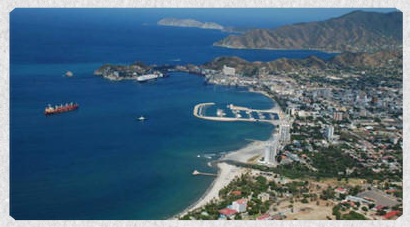
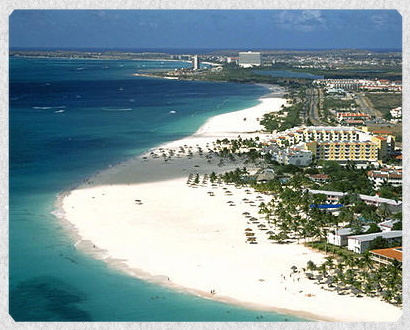 |
Well the title kind of gives it away. We did eventually
leave Curaçao in November 2011. First to the island ofAruba, the third of
the ABCs. Quite a different feel from the other two islands. It's a
major tourist destination, miles of golden beaches lined with miles of hotel
complexes fading off into the horizon and 2 or 3 cruise liners every day.
Like neighbouring Curaçao there is also a refinery, but the contribution to the
economy is tiny in comparison and there is talk of closing it down. Aruba
is tourism and inevitably the islanders have adopted a service mentality to fit.
Everyone is polite, everyone is friendly, everything is clean, but it does leave
a slightly sterile feeling. It's no-ones fault it's just the way it is -
After all, as a foreigner you're passing through. You're only going to be
there for a couple of weeks (hours in the case of cruise liner passengers) at
most, so the objective has to be to give you as good a time as possible whilst
getting you to spend as much as possible and then leave and recommend the island
to your friends. And they're very successful at it to judge from the
number of planes that take off and land over the anchorage every day.
So it's a great place for a couple of weeks of winter sun, snorkelling and diving but for us (and most cruisers) a place to shop, but not to stop, and they do have good supermarkets, with things on the shelves to cater to the tastes of every nationality - even Branston Pickle! All that said we ended up staying for a month, locating and waiting for spares to arrive, (as always). Our depth sounder's transponder had failed within minutes of leaving the dock in Curaçao, delaying our departure whilst we jury rigged a temporary fix. When we arrived in Aruba and had chance to check, we found that the company in New Zealand who made them had got into difficulties, run through several changes of ownership and finally gone out of business. For non sailors - the transponder fits in a tube which passes through the hull so unless we wanted to take the boat out of the water and make a new hole in the hull, it had to be replaced with an identical unit. |
| After much searching we located 30 NavMan transponders in a
warehouse in Oregon. The next day there were 28 and two were on their way
to us courtesy of FedEx. Easy-peasy! Actually not. The transponder
supplied with the US model was not the same size as the one supplied in the rest
of the world. It was electronically compatible, but it wouldn't fit in the
hole. Too big, so we couldn't even find a way of packing it in place.
More searching and we discovered a Belgian site that listed them - we asked for
photos this time. They were correct and they could be shipped that week.
Back in business!
Would anyone like to hear the story of the obsolete toilet pump clamp? No? OK, I'll move on, but if any one needs a US style NavMan depth transponder - you know where we are! |
|
| Bits received we were ready to leave on our next leg, to Santa Marta, Colombia. This would be a 300 mile downwind romp if not for the presence of Cabo De Vela, which has an evil reputation. "I passed it 20 miles off, and if I ever have to pass it again I'll pass it 200 miles off!" was the verdict of Miguel, a very experienced single handed Spaniard. So we waited for the calmest weather possible and set off with two reefs in the main. With such calm weather we aimed to pass the cape much closer, only a mile off, which would give us the option of anchoring behind it. After a rolly 100+miles the wind and sea built quite rapidly as we closed the cape. Not dangerous, but giving an idea of what a caldron it could become if the wind had been blowing hard for a few days. We decided not to stop. Firstly, even in the relatively benign conditions, turning towards the anchorage and putting ourselves beam on to the seas looked pretty uncomfortable, but also the forecast was for the wind to reduce further over the next 24 hours. So, if we stopped we might not have enough wind to make it to our final destination. There were ominous rain clouds over the mountains, but we hoped that they would remain there (they didn't). Incidentally, those "mountains", the Sierra Nevada, we now know are the end of the Andes chain which is the main reasons why Vela and the next cape Aguja build up so much wind around them - As do the capes at Baranquilla & Cartagena, which we'll have to pass when we head west - hurrah! | |
| So after a wet and squally night the sun came out in the
morning, the wind dropped, the sea flattened and our final miles into Santa
Marta were almost perfect. We dropped anchor outside the marina in the
late afternoon, to have a good night's sleep and get everything ready for
entering the marina the following day.
Santa Marta is the oldest city in Colombia (1525), but probably more famous for being the place where Simón Bolívar died, but although Bolívar was originally buried here, his remains were moved to Caracas shortly afterwards and although the Quinta de San Pedro Alejandrino where he died has been preserved as a low key museum, there's really not much trace of the great man left. In fact that seems to have been the high spot of Santa Marta's existence. It has long ago been overshadowed by Cartagena and until recently was just a sleepy seaside town with a coal loading harbour. Things have picked up a bit in the last few years though. President Uribe's success in tackling the narco-traffickers and the guerrillas has put tourism back on the agenda in Colombia and Santa Marta is the natural gateway to the Tayrona National Park and the construction of a large new IGY marina has started to attract the passing cruisers. |
|
| And it was the marina's strategic location and it's special
offer (pay for a month and get 10 days free) which had attracted us. We
arrived in early December with the plan of making it our base for Christmas and
the new year. It had attracted a lot of other sailors too and Christmas in
Santa Marta was to be a whirl of marina social life that we hadn't experienced
since leaving Europe. In fact it had quite a lot of similarities to our
first winter in Rota - another sleepy seaside town on the other side of the
world where we thoroughly enjoyed ourselves. Into the usual arrival routine of clearing in (courtesy of Dino - one needs an agent here), find the banks to get some cash, then the markets, supermarkets, etc - Ah yes an immediate reminder that we're back in South America now after the relative luxury of the Dutch islands. Then drinks with new neighbours (Dic & Lizzie on Indian Summer) then drinks with old neighbours, but in new country (Chantal & Jean Claude on Chamicha - arrived just after us, also from Curaçao via Aruba) and through them the other French boats. And Venus came here before us, also from Curaçao. And Joseph on Clarity, haven't seen him for a couple of years. And, and, and - it is truly a small world. |
|
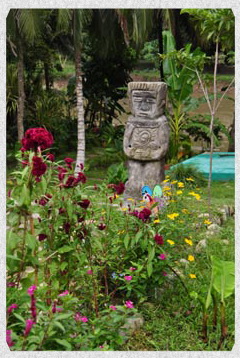 |
Then a trip into the Tayrona organised by "The Texans" Mike & Karen on Drifter, aptly named as they'd spent a couple of days on their way here without steering. |
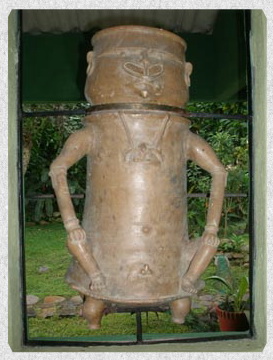 |
|
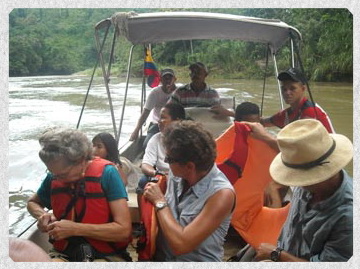 |
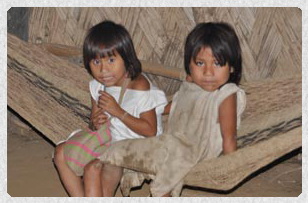 |
||
| And that was just the first week, and then it's almost Christmas. Dic organised a whip round for the Mariñeros (not difficult for us to make a big difference to their Christmases when you consider they only earn something like US$70 a week). We booked a table for 20 at El Bistro restaurant on Christmas Eve, which sees us rolling home at 04.30 on Christmas morning. Good thing we've already pre-prepped our contribution to the Christmas lunch party in the marina! Our Boxing Day had a slow start! | ||||
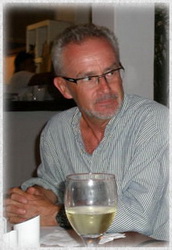 |
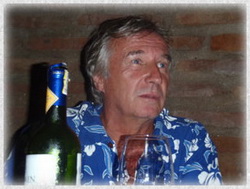 |
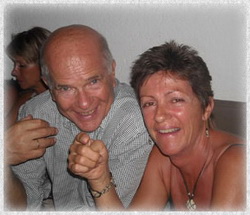 |
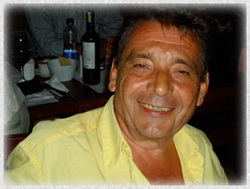 |
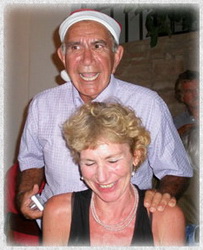 |
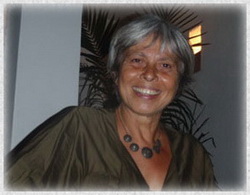 |
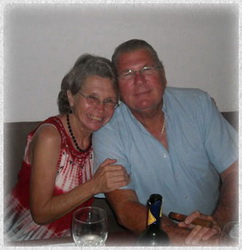 |
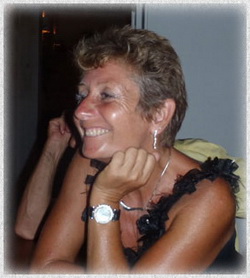 |
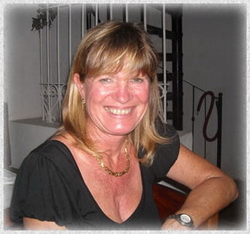 |
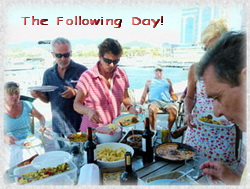 |
| We had another go at a party for New Years Eve. It was planned to be a smaller and shorter affair than Christmas, so this time we brought a couple of tables down onto the pontoons. It didn't go exactly to plan. The evening began windy and got steadily windier. Even at the beginning we were shouting at each other to be heard, a little later we were holding plates in place on the table and finally with the help of the mariñeros we were running additional lines to support the pontoons, which were gaping horribly. |
||||
| Santa Marta is an incredibly windy place.
It looks well protected on the chart, but the wind rolls down off the Sierra Nevada in
thundering gusts, particularly in December, January and February and it tends to be
worse at night. We regularly experienced 50+ knots and New Years
Eve was one of those nights. The locals call it La Brisa Loca! (No
translation necessary, I think.) Well the wind may be common
knowledge to the locals, but apparently not to the designer of the
marina. And perhaps, since the marina was to cut their beach in
half, the locals didn't feel disposed to tell them. However the
result is that the pontoons have been laid out so that the moored boats
are all more or less beam on to the prevailing wind and the majority of
the pontoon fingers are only connected at their base to the central pier (by
rubber shock absorbers), with no additional support at the other end.
The leverage exerted on the connections is enormous. Even with the
additional lines supporting them at least three pontoon fingers parted from the
pier over the new year period. Surprisingly (to me at least) it
wasn't the rubber doughnuts that gave out, but the welds on the
aluminium structure - peeled away like a banana skin.
Some of the swell created by all this wind works it's way around the headland and the marina entrance opens in that direction causing significant surge on some pontoons. Enough to snap one of our 20mm mooring lines! We resorted to our heavy duty spring shock absorbers - it's been a few years since we used those. |
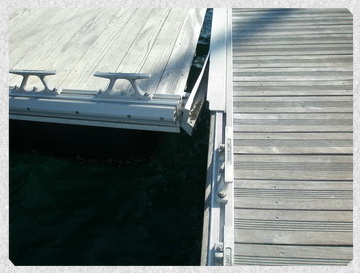 |
| And finally as an extra plus, the main port of Santa Marta just to
windward of the marina, majors on loading coal. So the howling wind
generally carries a liberal supply of coal dust. Generally, but not
always. No, about a third of the time when the wind has less north in it,
it blows across the beach and coats the boats with fine white sand instead.
Faults with the marina design to one side (I forgot to mention that less than half the pontoons have 220V) Santa Marta is a pretty nice place to spend some time. With a reasonable local airport with regular flights to Bogotá, it's also a base to explore more of Colombia. |
|
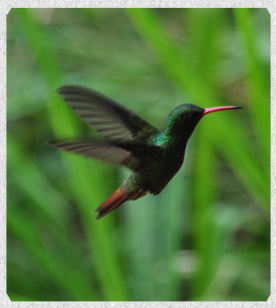 |
Our next trip didn't involve airports though, just a short long taxi ride up into the hills for a few nights in the village of Minca with Dic & Lizzie. Short, long because although Minca is only about 15 Km away, the state of the road means that the trip takes over an hour and is a little less than comfortable. Jean Claude described it perfectly as - "not exactly a road, more a lot of holes connected together!" Minca is known for it's hiking and bird watching. It took us a while to find a taxi to take us there, and the ones that would go all wanted nearly double the official rate. We didn't realise at the time, and in fact weren't to learn the reason for their reluctance until we chatted to the taxi driver who brought us back down a few days later. But, a few hours before we set off, the FARC had issued threats of reprisals following the government's capture of one of their leaders. And we now know that the threat was taken seriously enough that the shops and restaurants in Santa Marta were closed for two days as a precaution. So we missed all the excitement and instead spent a pleasant few days in the cool of the hills, walking, swimming in icy pools and marvelling at humming birds. |
|
 |
||
| The diary for the next few weeks is full of boats leaving, mostly heading west. The exception is Dic and Lizzy who head north for Jamaica. We had also considered Jamaica, and would have enjoyed spending some more time with them, but the forecast looked vile to us, so we "took a rain check". Another driver for the decision to stay put was that we also really needed to get hold of a package of stuff from the UK that was steadily increasing in size and included, amongst other things, those depth transponders, but more importantly new credit cards. Dic & Lizzie did indeed have a pretty grim trip, so we were glad to have missed it, but I think they're probably made of sterner stuff than us. | |
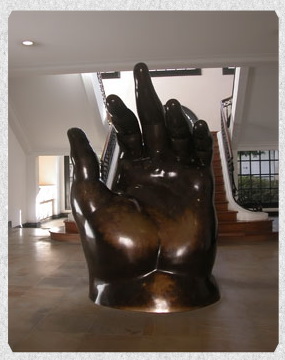 |
With no great weather window on the horizon, we decided instead to take a trip to Bogotá. And how would we describe Bogotá? Well if we were only allowed one word - it would have to be cold. Not the stuck on the highest chairlift in Val D'Isere in a blizzard, while they winch you back down manually because the motor's failed, type of cold. Actually, during the day with the sun out it's quite warm, but a cloud across the sun has you reaching for your jacket - if you've had the foresight to bring one that is. And at night it falls to single figures, but very rarely freezing. What this means is that whilst not exactly comfortable it's possible to exist without any form of heating. And that (except in the most upmarket of houses and hotels) is exactly how most Bogotanos do live. And it's also how we lived. We were provided with stacks of blankets, but the morning shower required an iron will! It also meant that we learned to select the restaurants for our evening meal not so much on the quality of the menu, the price or any of the normal things. Just on whether we could see a fire burning in the grate when we peered through the window. So, apart from the cold? We liked Bogotá. Candelaria (the old centre of the city), where most tourists are drawn is a bit grotty, but that's of course because it's the old part (sic). It's also where you find many of the tourist highlights. The Botero museum, all the work donated by the artist and free to enter was our personal favourite. The Gold Museum with the largest collection of pre-Colombian gold artefacts is also a "must see". |
| Off the tourist trail the areas of Zona G & Zona Rosa
are a different world. The new commercial centre of Bogotá. Shiny
office blocks, well dressed people, elegant shops, decent restaurants. And
all backed with upmarket housing crawling up onto the slopes of the mountains.
You could imagine yourself in the US or Europe. One thing we were really looking forward to was the Corrida, our first for more than six years. Bogotá is the centre of bull fighting in Colombia and we had bought tickets at the same time as we booked our flights. We set out on a beautiful sunny Sunday morning for a visit to the National Museum and lunch before the bull fight in the mid afternoon. |
 |
| We'd read that 50% of the roads were closed to traffic on Sundays to encourage the locals to get out and about on their bikes, but we weren't really expecting the sight that greeted us on the main avenues. Literally thousands of bikes, and every few hundred metres a "Bicycle Repair Tent" courtesy of the town hall, also people walking/jogging with lots of opportunity to stop on the side of the road for refreshments. Lunch was to be at Tabula. We knew nothing about it, except that like most restaurants in the area it didn't open at the weekend, but we had discovered that it did open on Sundays when there was a Corrida. | |
| Wow, what a surprise - a little piece of Spain.
An upmarket tapas bar filled to overflowing with the smart set of Bogotá
society, all going to the same place. We were lucky to be squeezed
in on a coffee table in the corner. Great food, great wine, great
atmosphere. Unfortunately, that was to be the high spot of the day. The Corrida itself was a like a pale caricature of the real thing. The first problem was the quality of the bulls - at least two of the six, were too poor to have been allowed into any decent Corrida in Spain. We've witnessed the crowd in Sevilla demand that better bulls than these be replaced! Added to that was the quality of the local matador who was absolutely incapable of killing cleanly. Thank God then for Pablo Hermoso - probably the most famous Spanish rejoneador - who fights the bull on horseback. He was spectacular, if only for his horsemanship, and made the trip worthwhile. He also had the best of a bad bunch of bulls - which always helps! |
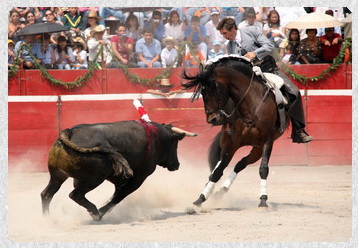 |
| Then it's back to Santa Marta where we have to renew our visas and extend
permission for the boat. Get fed up
waiting for the agent, and the deadline is getting closer, so we end up doing it
ourselves. They're a bit surprised to see foreigners at the Customs office 'cos
everyone uses an agent, but with a bit of help from the staff in the
office, it's not too tricky. We write out our request (in Lindy's best
handwriting), a lady from the Customs office visits the boat and after a couple
of days we're all done and we've saved $100. Then it's a trip to the dentist for the two of us and we're ready to leave. We've enjoyed our stay in Santa Marta, but it's time...................
|
